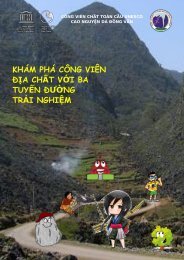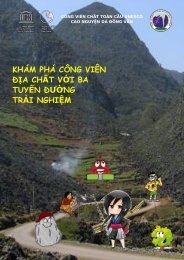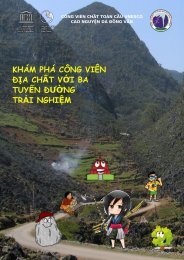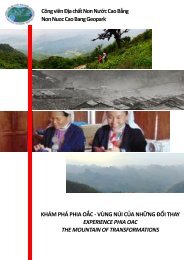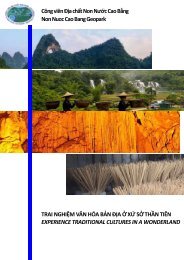Create successful ePaper yourself
Turn your PDF publications into a flip-book with our unique Google optimized e-Paper software.
The Caldera The North route route<br />
25<br />
Old German house<br />
The old German house was built by two German brothers<br />
named Adolph and Friedrich Siedentop who seled and farm<br />
in the Ngoro<strong>ngo</strong>ro crater unl the break of World War I. The<br />
first brother Adolph ente<strong>red</strong> the crater in 1899 as a squaer<br />
he started farming sisal, aer leasing the land from the<br />
administraon of German East Africa. The brothers regularly<br />
organized shoong pares to entertain their German friends.<br />
In 1916 the Siedentopf deports from Ngoro<strong>ngo</strong>ro leaving the<br />
house and the farm which fell into the Brish mandate in<br />
1920. The Brish established a veernary camp in Lerai and<br />
John Hamman took over the farm in lerai followed by<br />
Captain Hurst and later on Eric Howe.<br />
Recent the house is part of Lerai ranger post; the post is used<br />
by rangers who insure the security of the crater.<br />
© www.coolgeography.co.uk<br />
26 Lerai Forest<br />
The magical Lerai Forest of about 5 km2 is the more<br />
important forest inside the crater. It is home to the Yellow<br />
Fever tree (Acacia xanthophloea) aand constute a special<br />
refuge for many different species of animals: rhinos and<br />
elephants mainly. Lerai is a Maasai word referring to the tall<br />
yellow barked acacias. These beauful trees are old, gnarled<br />
by years of growing back the bark stripped off by elephants.<br />
© Family Leakey<br />
The forest is also a special bird habitat, providing food and<br />
nesng sites for hoopoes, cuckoos and weavers.<br />
Family Leakey and friends inside the outdoor dining room<br />
27<br />
Ngoitoktok<br />
As Seneto, Ngoitoktok is a perennial spring which is so<br />
abundant that a small lake has formed before spreading into<br />
the nearby Gorigor Swamp. A small rock outcrop with a<br />
single fig tree adorns the lake edge. Ngoitoktok is one of only<br />
two places where visitors are permied to get out of their<br />
vehicles. It's a great site for a bush picnic though beware of<br />
the large brown hawks that swoop down to snatch<br />
unaended food. Ngoitotok is inhabited by an important<br />
colony of hippopotamus; elephants, lions are also familair<br />
with this place.<br />
28<br />
Magadi Lake<br />
This shallow soda lake is is alkaline mainly due to deposits of<br />
volcanic ash. The depth, never more than three metres,<br />
varies during the year. During the rainy season Lake Magadi<br />
look pinkish from a distance due to the large flock of<br />
Flami<strong>ngo</strong>es.<br />
The birdlife is mainly seasonal, and is also affected by the<br />
rao of soda to fresh water in Lake Magadi. The lake's edges<br />
are favourite stalking grounds for golden jackals, lions and<br />
hyenas.<br />
©wikimedia commons<br />
20<br />
©Michael Lewin



